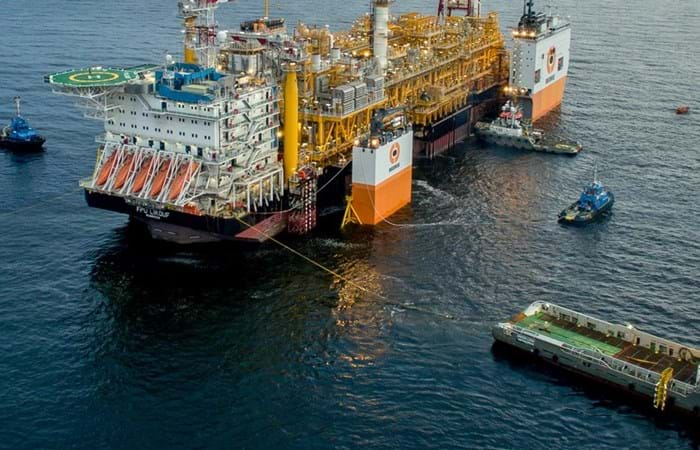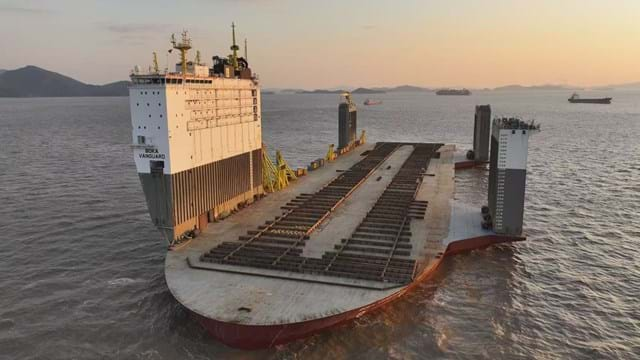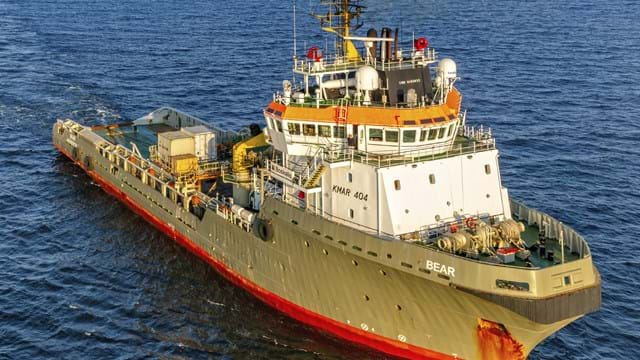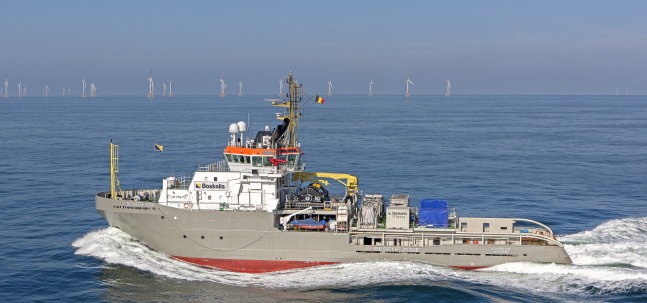For the Total Moho Nord FPU project, Dockwise has transported the newbuild FPU Likouf from the HHI fabrication yard in Ulsan, South Korea to the offshore discharge location near Port-Gentil, Gabon. It was a world-record cargo load onboard a semi-submersible vessel to date.
Boskalis sets new world record in heavy marine transport
On 16 November 2016, Boskalis subsidiary Dockwise successfully offloaded the newbuild Moho Nord Floating Production Unit (FPU) Likouf from the world’s largest semi-submersible heavy transport vessel Dockwise Vanguard. The huge, 80,500 ton FPU was transported from the fabrication yard in Ulsan, South Korea to Port-Gentil, Gabon. Both loading and offloading are crucial operations. They are the culmination of several years of preparation work. Right up to the execution preparations are made - from the loading schedule and sequence to communication lines, safety issues and lessons learned from previous offloading operations.
Preparation and outfitting
With the initial 58m gap between the casings of the Dockwise Vanguard it was not possible to float the Moho Nord FPU onto the deck. As a result the decision was taken to widen the gap to 70m, leaving 4m space between each side of the Moho Nord FPU once loaded. This meant outriggers had to be fabricated and fitted to the Dockwise Vanguard onto which the vessel’s casings were moved. Moving the casings not only enabled the Moho Nord transport but made the Dockwise Vanguard even more flexible for future projects, including the transport of the enormous Aasta Hansteen Spar hull from South Korea to Norway scheduled for 2017.
Float-on operation
Mid-September 2016, the Dockwise Vanguard was waiting at float-on location Ulsan Anchorage, South Korea. Some 25 staff were involved with the float-on operation. Due to the length and weight of the cargo loading conditions such as wave height, swell, current and wind speed are crucial. The entire process of ballasting the vessel, moving the Moho Nord FPU from the quayside, connecting tugger lines, positioning the FPU between the casings by tugs, towing the FPU on board using tugger lines and pre-installed guide posts followed by de-ballasting the submerged Vanguard encompassed a total operation time of about 18 hours. The vessel returned back to the quayside for sea-fastening activities and on the 1st of October, 2016 the vessel set sail to Gabon. During the voyage, the sea-fastenings and cribbing wood were carefully monitored by the vessel’s crew. "This is the heaviest cargo Dockwise has ever transported. It is quite a step forward, both in terms of weight and size" Taco Terpstra, project manager for Dockwise
225 people onboard the Moho Nord FPU
Manned transportation of floating facilities is nothing new, but for the Moho Nord FPU project Dockwise took the next step in creating the opportunity to allow up to 225 riders onboard the FPU, to facilitate the operators to continue their pre-commissioning programs already upon departure from the yard until the arrival in the field. The interpretation of existing rules and regulations as well as all possible safety considerations had to be discussed in the entire project team before successful application of flag state approval could be applied.
Float-off operation
After a journey of about 10,500 n.m., through the Sunda Strait and around Cape of Good Hope, the FPU safely arrived in the Bay of Port-Gentil, Gabon The final stage of cutting of the sea-fastenings was done in less than 24 hours as many cutting preparations were done during the last days of the voyage. In a neat piece of synchronicity Dockwise parent company Boskalis provided three anchor handling tugs (AHTs) vessels and two Smit Lamnalco harbor tugs for the float-off and tow to the field offshore Congo. On the morning of 16 November 2016 the FPU Likouf was successfully refloated after which the Dockwise Vanguard set sail to Singapore for reinstatement.
Wet tow and station keeping
Following the float-off the FPU was towed by the AHTs Union Manta and Union Lynx from Port Gentil to the Moho Nord field offshore Congo. Upon arrival in Congo, after three days of towing, station keeping of the FPU commenced by the Union Manta, Union Bear, Union Lynx and Union Sovereign. The Union Princess was on stand-by. After eight days the hook-up was completed successfully and all AHTs were released from station keeping activities.
Exceptional
It’s the latest in a string of exceptional loads, including ENI’s 64,000-tonne Goliat Sevan-design cylindrical floating production, storage, and offloading vessel (FPSO) and the 60,000-tonne, 254m-long, Armada Intrepid, previously known as the Schiehallion FPSO, which was the Dockwise Vanguard’s first ship-shaped FPSO transport. By proving these exceptional cargoes can be loaded and transported safely and efficiently, Dockwise has taken dry heavy marine transport to the next level with its flagship the Dockwise Vanguard.
FPU Likouf
- Weight 80,500 mt
- Length Overall 252.00 m
- Width Overall 62.00 m
- Total Height 140.00 m
- Hull Length 245.00 m
- Hull Width 44.00 m
- Hull Depth 18.00 m
- Cargo Loading Draft 7.80 m
Dockwise Vanguard
The Dockwise Vanguard is a unique vessel capable of transporting extremely large cargoes. As the world's largest semi-submersible heavy transport vessel, it offers an unprecedented capability for transporting fully-integrated offshore structures and units, including FPSOs. The Dockwise Vanguard has a load capacity in excess of 110,000 mt, accommodated on an open-end, free deck space of 275m x 70m. The absence of a raised bow and conventional forward superstructure means that cargo overhang, either forward or aft, is possible. The vessel entered service in February 2013.





